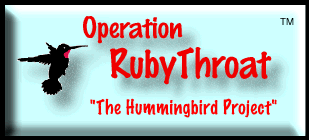 HOME: www.hiltonpond.org |
|||
|
RUFOUS HUMMINGBIRD |
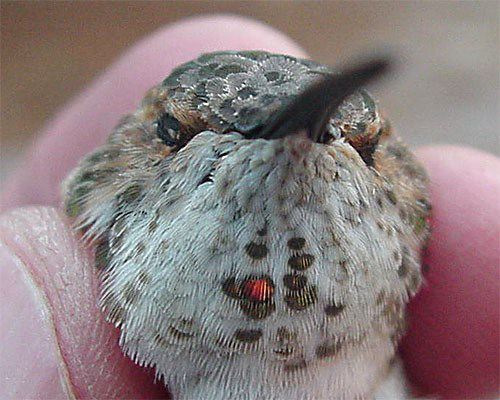 To our knowledge, nearly all South Carolina's vagrant hummingbird reports in Fall 2002 have been from the coastal counties or the northwestern corner of the state, with almost none reported from the Midlands. So, on 18 December we traveled to Lexington County in central South Carolina to investigate a "winter hummer" that apparently has been visiting a feeder at the home of James Francum since early October. 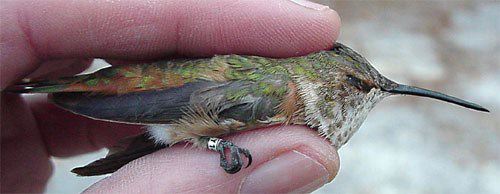 One of James' golfing buddies got him hooked on feeding hummingbirds last summer and was startled to learn that James still had one coming to his feeder after his Ruby-throated Hummingbirds had departed in fall migration. Recently, James' friend read in the Columbia Star weekly newspaper about "Operation RubyThroat: The Hummingbird Project" and our winter hummingbird research and suggested that James contact us about his unusual sighting. After working out the logistics with James, we journeyed from Hilton Pond Center to the Francum residence in Lexington and arrived at about 7:15 a.m. We knew the way because almost exactly a year ago we visited another house just three miles from the Francums' to band South Carolina's first recorded Buff-bellied Hummingbird. Must be something about the neighborhood . . . .
James uses a Perky-Pet feeder that attaches directly to glass on the living room window of his house. To catch the hummer we moved the feeder into our portable trap and hung the whole contraption from one of the window shutters. As we did so, the hummer made a brief inspection but departed when we turned our head to get a better view. After setting and testing the trap, we walked back to our van and climbed into the driver's seat to wait for the hummer's return. By the time we shut the door and picked up our binoculars the hummingbird was already inside the trap, so we pushed the remote trigger and had the hummer in hand by 7:23 a.m. Sometimes things are TOO easy! (Knock on wood.) 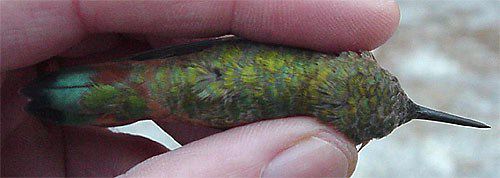 Even in the dim morning light we could see that our new capture was a Selasphorus hummingbird with rust color at the base of its tail feathers. The overall "feel" of the bird was female Rufous, but young males resemble females in that species. Based on tail feather width, we ruled out Allen's, but one of the other measurements raised a red flag when it came to sexing the bird: the 42mm wing chord measurement was a bit short for a female Rufous; usually females range 42.6 to 46.6mm, while young males range 38.1 to 42.5mm. Nonetheless, all other measurements--plus bill condition and tail feather shape--led us to conclude the bird was an adult female Rufous Hummingbird that hatched out sometime prior to 2002. Age/Sex--After-hatch-year female Weight--3.4g Wing Chord--42.0mm Tail Length--27mm Tail Fork--7mm Culmen (upper bill)--18.5mm
If you're interested in sharing your hummingbird observations and learning from other enthusiasts, you may wish to subscribe to Hummingbird Hobnob, our Yahoo!-based discussion group. Also be sure to visit our award-winning Web site for Operation RubyThroat: The Hummingbird Project; on it you'll find almost anything you want to know about hummingbirds, including more information about Hummingbird Banding.
For much more information about hummingbirds, visit Operation RubyThroat: The Hummingbird Project |

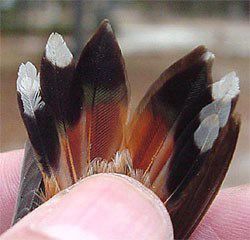 She also had seven red-orange metallic gorget feathers--more or less typical of most young male and adult female Rufous Hummingbirds. As always, we reserved final judgment until taking measurements that differentiate Rufous (S. rufus) from the slightly smaller Allen's Hummingbird (S. sasin), and that allow sexing.
She also had seven red-orange metallic gorget feathers--more or less typical of most young male and adult female Rufous Hummingbirds. As always, we reserved final judgment until taking measurements that differentiate Rufous (S. rufus) from the slightly smaller Allen's Hummingbird (S. sasin), and that allow sexing.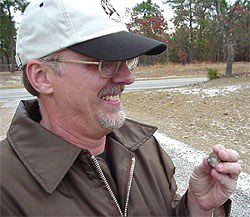 When we completed the banding procedure and hand-fed the Rufous, James got a chance to hold his hummer--which upon release flew to a nearby pine, perhaps to ponder its recent encounter with humans. Thanks to James for contacting us about the vagrant and for allowing us to visit his home to band the bird. Who knows what other winter hummers may show up in the Lexington area this winter?
When we completed the banding procedure and hand-fed the Rufous, James got a chance to hold his hummer--which upon release flew to a nearby pine, perhaps to ponder its recent encounter with humans. Thanks to James for contacting us about the vagrant and for allowing us to visit his home to band the bird. Who knows what other winter hummers may show up in the Lexington area this winter?
 Students at GLOBE-certified schools may submit winter hummingbird observations as part of Operation RubyThroat and GLOBE. Students can also correlate hummingbird observations with data on abiotic factors, including atmosphere, climate, hydrology, soils, land cover, and phenology. See the
Students at GLOBE-certified schools may submit winter hummingbird observations as part of Operation RubyThroat and GLOBE. Students can also correlate hummingbird observations with data on abiotic factors, including atmosphere, climate, hydrology, soils, land cover, and phenology. See the 